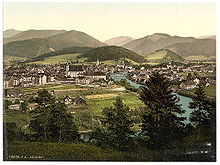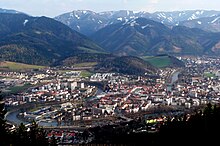Leoben
This article needs additional citations for verification. (June 2009) |
You can help expand this article with text translated from the corresponding article in German. (June 2010) Click [show] for important translation instructions.
|
Template:Infobox Ort in Österreich Leoben (German pronunciation: [leˈoːbn̩]) is a Styrian city in central Austria, located by the Mur river. With a population of about 25,000 it is a local industrial center and hosts the Montanuniversität Leoben, which specialises in mining. The Peace of Leoben, an armistice between Austria and France preliminary to the Treaty of Campo Formio, was signed in Leoben in 1797.
The Justice Center Leoben is a prison designed by architect Josef Hohensinn, which was completed in 2005.
Past and present

Leoben is known as the “Gateway to the Styrian Iron Road”. The 13th century Main Square features the Hackl House with its baroque façade in red and white. The City Parish Church, St. Francis Xavier, built in 1660, comprises a 17th-century interior and is considered one of the most significant Jesuit churches in Austria. Also of note is the Art Nouveau Lutheran church which is at the upper end of the Franz-Josef-Strasse.
The oldest convent for women in Styria is Göss Abbey. Founded in 1020 A.D., it was run by the Benedictine nuns until it was dissolved in 1782. The early Romanesque crypt is of note as is the 'Gösser Ornat,' which can be seen in Vienna (Museum for Applied Arts). Next to the convent is the Gösser brewery, which includes a brewery museum.
Current cultural events include classical concerts in the Congress Leoben, productions of the Summer Philharmonic in July and performances of local and guest productions in the oldest operating theater in Austria.[1]
Tradition & Avantgarde


Leoben was shaped for centuries by the trade in iron and the research in raw materials carried out at the Montanuniversität Leoben, which was founded in 1840. Mining traditions still play an important part in city life. Examples are the Miners' Parade, the St. Barbara Celebration or the Ledersprung ("Leather Jump"). The Gösser Kirtag, a street fair, takes place on the Thursday after the first Sunday in October and attracts tens of thousands of visitors to Leoben.
Other components of the vigorous cultural life of the "Mining City" include classical concerts in the Congress Leoben, productions of the Summer Philharmonics in July and performances of locally created and guest productions in the oldest still-running theatre in Austria.
Notable people
- Egon Kapellari, bishop
- Roland Linz, football player
- Wilfried Morawetz, botanist[2]
- "Bambikiller" Chris Raaber, professional wrestler
- Walter Schachner (aka "Schoko"), football trainer
- Martin Weinek, actor
- Tracey Gilmore, Australian politician
References
- ^ City of Leoben: A City on the move. In: City of Leoben
- ^ de:Wilfried Morawetz
